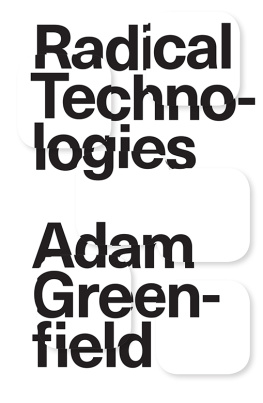Adam Greenfield - Radical Technologies: The Design of Everyday Life
Here you can read online Adam Greenfield - Radical Technologies: The Design of Everyday Life full text of the book (entire story) in english for free. Download pdf and epub, get meaning, cover and reviews about this ebook. year: 2017, publisher: Verso, genre: Science. Description of the work, (preface) as well as reviews are available. Best literature library LitArk.com created for fans of good reading and offers a wide selection of genres:
Romance novel
Science fiction
Adventure
Detective
Science
History
Home and family
Prose
Art
Politics
Computer
Non-fiction
Religion
Business
Children
Humor
Choose a favorite category and find really read worthwhile books. Enjoy immersion in the world of imagination, feel the emotions of the characters or learn something new for yourself, make an fascinating discovery.
- Book:Radical Technologies: The Design of Everyday Life
- Author:
- Publisher:Verso
- Genre:
- Year:2017
- Rating:3 / 5
- Favourites:Add to favourites
- Your mark:
- 60
- 1
- 2
- 3
- 4
- 5
Radical Technologies: The Design of Everyday Life: summary, description and annotation
We offer to read an annotation, description, summary or preface (depends on what the author of the book "Radical Technologies: The Design of Everyday Life" wrote himself). If you haven't found the necessary information about the book — write in the comments, we will try to find it.
Radical Technologies: The Design of Everyday Life — read online for free the complete book (whole text) full work
Below is the text of the book, divided by pages. System saving the place of the last page read, allows you to conveniently read the book "Radical Technologies: The Design of Everyday Life" online for free, without having to search again every time where you left off. Put a bookmark, and you can go to the page where you finished reading at any time.
Font size:
Interval:
Bookmark:

The Design of Everyday Life
Adam Greenfield

First published by Verso 2017
Adam Greenfield 2017
All rights reserved
The moral rights of the author have been asserted
1 3 5 7 9 10 8 6 4 2
Verso
UK: 6 Meard Street, London W1F 0EG
US: 20 Jay Street, Suite 1010, Brooklyn, NY 11201
versobooks.com
Verso is the imprint of New Left Books
ISBN-13: 978-1-78478-043-2
ISBN-13: 978-1-78663-449-8 (EXPORT)
ISBN-13: 978-1-78478- 047-0 (US EBK)
ISBN-13: 978-1-78478- 046-3 (UK EBK)
British Library Cataloguing in Publication Data
A catalogue record for this book is available from the British Library
Library of Congress Cataloging-in-Publication Data
Names: Greenfield, Adam, author.
Title: Radical technologies : the design of everyday
life / Adam Greenfield.
Description: Brooklyn, NY : Verso, 2017. | Includes
bibliographical
references and index.
Identifiers: LCCN 2017011127| ISBN 9781784780432
(hardback) | ISBN
9781786634498 (export) | ISBN 9781784780470
(US ebk) | ISBN 9781784780463
(Uk ebk)
Subjects: LCSH: Ubiquitous computing. | Electronic
data processingSocial
aspects. | Technological innovationsSocial
aspects. | Telematics. | Work
design.
Classification: LCC QA76.5915 .G745 2017 | DDC
004dc23
LC record available at
https://lccn.loc.gov/2017011127
Typeset in Sabon by MJ & N Gavan, Truro, Cornwall
Printed in the UK by CPI Mackays, UK
For N., the light on your door to show that youre home.
One has to become a cybernetician to remain a humanist.
Peter Sloterdijk
Its a few moments before six in Paris, on a damp evening in early spring. From Montreuil in the east to Neuilly-sur-Seine in the west, streetlights wink on in a slow wave as their sensors register the falling dusk. Theres a rush-hour backup approaching the Porte dOrlans exit on the Priphrique; in front of a BNP Paribas ATM in the Rue de Svres, a brief scuffle breaks out between supporters of the Paris Saint-Germain and Olympique de Marseille football clubs. Two friends from Sciences-Po laugh abashedly, as they recognize one another before one of the few tatty multiplexes remaining on the Champs-lysestheyre in line to pick up tickets for the 6:15 showing of an American blockbuster. Not far away, in the Avenue Carnot, a flic pins a suspected purse-snatcher to the wall; affecting nonchalance as he waits for a van to come pick them up, he leans into the mans back, putting all his weight behind the point of his elbow.
A municipal street-cleaner churns slowly through the streets of the Marais, hosing the days grit and dust from the asphalt. Across town, on the Boulevard Ney in the 18th Arrondissement, a bored Ghanaian streetwalker seeks shelter from a brief downpour beneath the awning of a pharmacy, her emerald-daubed nails clacking on the screen of her phone as she checks her messages. In the Rue Saint-Honor, a fashion executive urges her two matched Standard Poodles from the back of the black Mercedes that has just deposited her in front of her office. An American backpacker on a post-collegiate month abroad strides forth from the marble gate of Pre Lachaise with a shoplifted Gide wedged in the cargo pocket of his fatigue pants. And way out in Torcy, RER cars are being switched from a siding to the main rail line, bound for Les Halles and the other stations of the center.
In this city, everyone with a mobile phone reveals their locationwhether or not the phone is equipped with explicitly locative technology, whether or not the phone is even turned on. Every transaction in the bistros and shops and cafs generates a trail, just as every bus and car and Vlib bicycle throws its own data shadow. Even the joggers in the Bois du Boulogne cast a constant, incrementing tally of miles logged and calories burned.
This is Paris: all of it, all at once. In any previous epoch, all of these events might have transpired unobserved and unmarked. Even the most sensitive observer could never hope to witness or impress upon their recollection more than the tiniest fraction of them, however long they watched the city go by. And any information or potential insight bound up in the flow of events fell to the ground like a silent, diffuse drizzle, forever lost to introspection, analysis, and memory.
But now these flows can be traced, at least in principle, and plotted in space and time. Latent patterns and unexpected correlations can be identified, in turn suggesting points of effective intervention to those with a mind to exert control. All of the living citys rhythms make themselves plain, more rhythms than anyone would have dared to dream of: anticipations, reversals, slight returns. Stutters, stops, and lags; doublings and crashes. And all of this is possible because of the vast array of data-collecting devices that have been seeded throughout the quotidian environment, the barely visible network that binds them, and the interface devices just about everyone moving through the city carries on their person.
Which rhythms, precisely? Traffic cameras and roadway sensors log the slowdown on the Priphrique; it shows up as a thick red line splashed across a hundred thousand electronic road signs, dashboard navigation units and smartphone screens, and as a new weighting in the routing algorithms that guide whatever trips are planned at that hour. Here are the rhythms of daily mobility and, by extension, the broader economy.
The ATMs security camera captures the precise details of who did what to whom in the scuffle, and when; the identities of the participants can be reconstructed later on, if need be, by a state-sanctioned trawl of the transaction records. Those identity files will almost certainly note an individuals allegiance to a particular football club, that theyve been photographed at a Nuit Debout assembly, or have social or familial links to suspected jihadists. As with the traffic, here too we can begin to make correlations, mapping outbreaks of aggression against other observed phenomenathe league schedule, perhaps, or the phase of the moon, or the unemployment index. Or even something comparatively unexpected, like the price of discount-airline tickets. Here are the rhythms of collective mood.
The friends who were so embarrassed to run into one another at a superhero movie? They reserved their tickets online using their phones, and in so doing broadcast their choice for all to see, at least in aggregate; they might be surprised to learn that those who purchase tickets in this way in the streets around their campus appear to have a marked fondness for Hollywood action flicks. Here are correlated geographical patterns of socialization and economic activity, and the rhythms of media consumption.
The Avenue Carnot is nowhere to be found in any official record of the bag-snatching incident. In all the relevant entries, the offense is associated with the location where it was reported, a few blocks away in the rue de Tilsitt, and so that is how it shows up in both the citys official statistics and a citizen-generated online map of risk in Paris; in fact, this kind of slippage between an event that happens in the world and the events representation in the networked record is routine. But the arrogant insouciance of the arresting flics posture bothers a lyce student passing by, who snaps a picture with her phone and submits it, time- and location-stamped, to the Commission Citoyens Justice Police, a civilian review board. In this constellation of facts, we can see something about the frequency with which particular kinds of crimes are committed in a given location, the type and density of policing resources deployed to address them, and the frictions between the police and the communities in which they operate. Here, then, are the contrapuntal rhythms of crime, its control and the response to that control.
Font size:
Interval:
Bookmark:
Similar books «Radical Technologies: The Design of Everyday Life»
Look at similar books to Radical Technologies: The Design of Everyday Life. We have selected literature similar in name and meaning in the hope of providing readers with more options to find new, interesting, not yet read works.
Discussion, reviews of the book Radical Technologies: The Design of Everyday Life and just readers' own opinions. Leave your comments, write what you think about the work, its meaning or the main characters. Specify what exactly you liked and what you didn't like, and why you think so.








